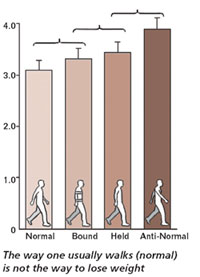The way you swing
 OUR nomadic ancestors had to quickly cover long distances while hunting. A prey that ran faster had to be outrun. While running after the animal they constantly moved their arms; it reduced the effort and counterbalanced the body weight. People now run after buses, sprinters run to win a medal. But the dynamics of running have not changed. What a team was interested in knowing was why humans swing their arms even while walking.
OUR nomadic ancestors had to quickly cover long distances while hunting. A prey that ran faster had to be outrun. While running after the animal they constantly moved their arms; it reduced the effort and counterbalanced the body weight. People now run after buses, sprinters run to win a medal. But the dynamics of running have not changed. What a team was interested in knowing was why humans swing their arms even while walking.
The researchers from the University of Michigan, USA and Delft University of Technology, Netherlands, studied arm swinging that goes into a walk and concluded that it is an energy conservation measure. If humans do not swing their arms normally while walking, they will burn more energy. Health enthusiasts who take early morning walks in parks to lose some flab should change the way they swing their arms.
The team developed a walking model to test its theory. Even with no force driving it, the model easily produced a walking gait similar to humans. When the model swung its arms in a way that opposed the normal mode of walk, it required muscular effort. This proved that swinging arms normally while walking requires little muscular effort. Whether it yields energetic benefits or not the team found out next.
Ten people were asked to walk in four ways: normally, arms clamped by the sides, arms held loosely by the sides and arms swinging anti-normally. In the anti-normal mode, the right arm moved with the right leg and vice-versa.
Barring the normal swing, the body burnt energy in all the other modes. Metabolic rate was the lowest in the normal walk. It increased 7 per cent in bound condition, 12 per cent in the held position and was 26 per cent greater than normal in the anti-normal mode.
Related Content
- Telangana State Pollution Control Board report on Mazid Banda lake, 15/08/2023
- Order of the National Green Tribunal regarding unrestricted construction of hotels and resorts alongside Jayanti dam, Alipurdua, West Bengal, 18/11/2021
- G20 climate risk atlas: India
- Order of the High Court of Delhi regarding steps taken to tackle COVID-19 in Delhi, 20/04/2021
- LDCs, negotiations and the climate crisis: Will the poorest countries benefit from the COP24 climate package?
- Understanding the drought impact of El Niño/La Niña in the grain production areas in Eastern Europe and Central Asia (ECA): Russia, Ukraine, and Kazakhstan (RUK)
